|
Jupiter is the fifth and largest planet in our solar system. This
gas giant has a thick atmosphere, 39 known moons, and a dark, barely-visible ring. Its most prominent features are bands across
its latitudes and a great red spot (which is a storm).
Jupiter is composed mostly of gas. This enormous planet radiates
twice as much heat as it absorbs from the Sun. It also has an extremely strong magnetic field. It is slightly flattened
at its poles and it bulges out a bit at the equator.
ATMOSPHERE AND PLANETARY COMPOSITION
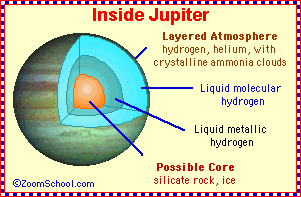 Atmosphere: Jupiter is a gaseous planet; it does not have a solid surface like the Earth does (but probably has a solid, rocky
core 10 to 15 times the mass of the Earth). When we look at Jupiter, we are seeing icy clouds of gases moving at high speeds
in the atmosphere. Jupiter's atmosphere is composed of about 90% hydrogen and 10 % helium. There are only minute traces (0.07%) of methane (CH3), water,
ammonia, and rock dust. Atmosphere: Jupiter is a gaseous planet; it does not have a solid surface like the Earth does (but probably has a solid, rocky
core 10 to 15 times the mass of the Earth). When we look at Jupiter, we are seeing icy clouds of gases moving at high speeds
in the atmosphere. Jupiter's atmosphere is composed of about 90% hydrogen and 10 % helium. There are only minute traces (0.07%) of methane (CH3), water,
ammonia, and rock dust.
Mantle: Pressurized hydrogen in the mantle may generate electric currents which generate Jupiter's
powerful magnetic field. The outer mantle is liquid hydrogen; the inner mantle is liquid metallic hydrogen. The layers of
extraordinarily-compressed hydrogen are in a state so extreme that it has never been produced on Earth. The pressure is so
great that the hydrogen molecules inside Jupiter conduct heat and electricity very well, in a metal-like fashion (they do
not do this under Earth-like condition). Inside Jupiter, electrons from hydrogen molecules move freely from molecule to molecule
(like the electrons of a metal); this is what allows the electrical and heat conductivity. Core: At the center of the planet is a molten rock core which is many
times bigger and more massive than the entire Earth. It is 20,000 °C, about three times hotter than the Earth's core.
Internal Heat: Jupiter is a heat source; it radiates 1.6 times a much
energy as it receives from the Sun. This energy is produced by Jupiter's shrinking due to gravity, and this produces heat.
Also, it is still cooling down, losing its initial energy (the energy it received as the Solar System formed).
Does Jupiter produce energy by nuclear fusion -- NO. Jupiter,
the biggest of the gas giants, is too small to produce a core temperature that is hot enough to undergo fusion (you need about
3 million degrees to start the fusion of hydrogen). You'd need a body that was many times the mass of Jupiter to get nuclear
fusion (the theoretical limit is about 8 percent of the mass of the Sun).
Magnetic Field: Jupiter has a very strong
magnetic field. The magnetic field is probably generated as the planet spins its deep metallic-hydrogen layer with electrical
currents .
Jupiter's magnetic field (Jupiter's magnetosphere) extends for millions of miles into space. The tail of
this magnetic field (which is extended by the solar wind), extends into the orbit of Saturn! A tremendous amount of charged
particles are trapped within this magnetosphere, especially in the inner parts of this field. This makes Jupiter the most
deadly radiation environment of any of the planets.
SIZE
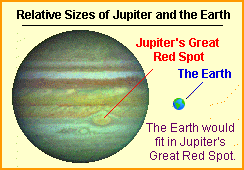 Jupiter's diameter is 88,700 miles (142,800 km). This is a little more than 11 times the diameter of the Earth. Jupiter is so big that all the other planets in our Solar System could fit inside Jupiter (if it were hollow). Jupiter's diameter is 88,700 miles (142,800 km). This is a little more than 11 times the diameter of the Earth. Jupiter is so big that all the other planets in our Solar System could fit inside Jupiter (if it were hollow).
MASS AND GRAVITY
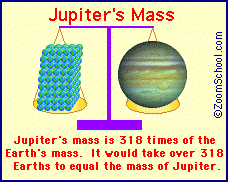 Jupiter's mass is about 1.9 x 10 27 kg. Although this is 318 times the mass of the Earth, the gravity on Jupiter
is only 254% of the gravity on Earth. This is because Jupiter is such a large planet (and the gravitational force a planet
exerts upon an object at the planet's surface is proportional to its mass and to the inverse of its radius squared). A
100-pound person would weigh 254 pounds on Jupiter. LENGTH OF A DAY AND YEAR ON JUPITER
It takes Jupiter 9.8 Earth hours to revolve around its axis (this is a Jovian day). It takes 11.86
Earth years for Jupiter to orbit the sun once (this is a Jovian year).
Jupiter is made up of gases and liquids, so
as it rotates, its parts do not rotate at exactly the same velocity. It rotates very rapidly, and this spinning action gives
Jupiter a large equatorial bulge; it looks like a slightly-flattened sphere (it is oblate)
JUPITER'S
ORBIT
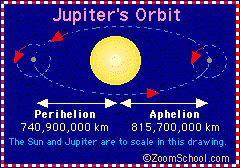 Jupiter is 5.2 times farther from than the Sun than the Earth. On average, it is 480,000,000 miles (778,330,000 km)
from the sun. Jupiter is 5.2 times farther from than the Sun than the Earth. On average, it is 480,000,000 miles (778,330,000 km)
from the sun.
At aphelion (the place in its orbit where Jupiter is farthest from the Sun), Jupiter is 815,700,000
km from the Sun. At perihelion (the place in its orbit where Jupiter is closest to the Sun), Jupiter is 749,900,000 km from
the Sun. Jupiter has no seasons. Seasons are caused by a tilted
axis, and Jupiter's axis is only tilted 3 degrees (not enough to cause seasons).
JUPITER'S MOONS
Jupiter has four large moons and dozens of smaller ones (there are
about 60 known moons so far). Galileo first discovered the four largest moons of Jupiter,
Io, Europa, Ganymede, and Callisto in 1610, using a 20-power telescope; these moons are known as the Galilean moons.
The
moons of Jupiter are (in order by their distance from Jupiter): Metis, Adrastea, Amalthea, Thebe, Io, Europa, Ganymede (the
biggest), Callisto (the second biggest), Leda (the smallest), Himalia, Lysithea, Elara, Ananke, Carme, Pasiphae, Sinope, and
many newly-discovered moons that haven't been named yet.
 METIS METIS
Metis is the closest moon to Jupiter. Metis is 25 miles (40 km) in diameter and orbits 79,500 miles (128,000 km)
from Jupiter, within its main ring. Metis and the next moon, Adrastea, are probably the source of the dust in this ring. Metis
has a mass of 9 x 1016kg. It orbits Jupiter in 0.294780 (Earth) days; this is faster than Jupiter rotates on its
axis. Metis was discovered by Stephen Synnott (Voyager 2) in 1980. |
 ADRASTEA ADRASTEA
Adrastea is the second-closest moon to Jupiter. Adrastea is 12 miles (20 km) in diameter and orbits 80,000 miles
(129,000 km) from Jupiter, within its main ring. Adrastea and the first moon, Metis, are probably the source of the dust in
this ring. Adrastea has a mass of 1.91 x 1016kg. It orbits Jupiter in 0.29826 (Earth) days; this is faster than
Jupiter rotates on its axis. Adrastea was discovered by D. Jewitt and E. Danielson (Voyager 2) in 1979. |
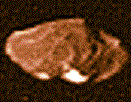 AMALTHEA AMALTHEA
Amalthea is the third-closest moon to Jupiter and the reddest object in our solar system . Amalthea is 145 x 91
x 83 miles (232 x146 x134 km) in diameter and orbits 112,700 miles (181,300 km) from Jupiter, within the faint Gossamer ring.
Amalthea and Thebe likely provide the dust for the Gossamer ring. Amalthea has a mass of 7.2 x 1021kg. It orbits
Jupiter in 0.49817905 (Earth) days and is in synchronous rotation (always keeping the same side facing Jupiter). Amalthea
gives off more heat than it receives from the Sun. Amalthea was discovered by Edward Emerson Barnard in 1892. |
 THEBE THEBE
Thebe is the fourth-closest moon to Jupiter. Thebe is 68 x 56 miles (110 x 90 km) in diameter and orbits 138,000
miles (222,000 km) from Jupiter. Amalthea and Thebe likely provide the dust for the Gossamer ring. Thebe has a mass of 8 x
1017kg. It orbits Jupiter in 0.6745 day (Earth) days and is in synchronous rotation (always keeping the same side
facing Jupiter). Thebe was discovered by Stephen Synnott (Voyager 1) in 1980. |
THE GALILEAN MOONS
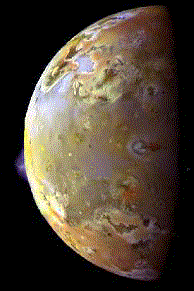
Two sulfurous eruptions on Io. Pillan Patera, a volcanic caldera at the left, spews sulfur 86 miles above the surface. | 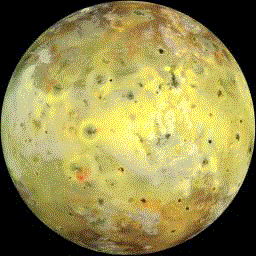 IO IO
Io is a large, rocky, volcanically active moon of Jupiter. Its volcanoes
spew out molten sulfur, making Io a very colorful moon. It is the innermost of Jupiter's four large moons and the third largest.
It has a diameter of 1,942 miles (3,636 km), very close in size to our moon. Io's mean distance from Jupiter is 220,000 miles (422,000 km).
It has a mass of 8.93x1022 kg. It takes Io 1.77 days to orbit Jupiter. There is a doughnut-shaped plasma cloud
around Jupiter near Io's orbit (known as the "Io plasma torus") This torus is caused by Jupiter's strong magnetic field, which
strips ions from Io as it rotates; Io acts like an electrical generator. Io was discovered by Galileo and Marius (independently)
in 1610.
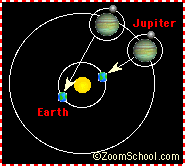 Ole Romer (1644-1710) was a Danish astronomer who, in 1675-1676, was the first person to demonstrate that the
speed of light is finite. Romer did this by observing eclipses of Jupiter's moon Io as Jupiter's distance from Earth varied through the year. He noticed that the observed period of
Io's orbit differed by about 20 minutes; he concluded that this difference was due to the extra distance that the light had
to travel to Earth. His calculations put the speed of light at about 225,000 kilometers per second (it is really a bit faster,
at 299,792 kilometers per second). Ole Romer (1644-1710) was a Danish astronomer who, in 1675-1676, was the first person to demonstrate that the
speed of light is finite. Romer did this by observing eclipses of Jupiter's moon Io as Jupiter's distance from Earth varied through the year. He noticed that the observed period of
Io's orbit differed by about 20 minutes; he concluded that this difference was due to the extra distance that the light had
to travel to Earth. His calculations put the speed of light at about 225,000 kilometers per second (it is really a bit faster,
at 299,792 kilometers per second). |
  EUROPA EUROPA
Europa is a large, dense, icy moon of Jupiter. Europa is the smoothest
object in our Solar System. Its surface is covered with long, crisscrossing trackways (but
few craters) on water ice. Frozen sulfuric acid has been found on its surface. Europa's diameter is less than 2,000 miles
(3,138 km), smaller than the Earth's moon. It takes Europa 3.55 days to orbit Jupiter (in a synchronous
orbit). Its mean distance from Jupiter is about 420,000 miles (670,900 km). Its mass is 4.80x1022 kg. It was discovered
by Galileo and S. Marius (independently) in 1610. |
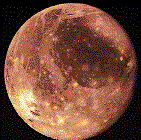  GANYMEDE GANYMEDE
Ganymede is the largest moon of Jupiter, a large, icy, outer moon that is scarred with impact craters and many
parallel faults. It has a diameter of about 3,400 miles (5,268 km) and orbits Jupiter at a mean distance of 664,000 miles
(1,070,000 km). It has a magnetic field and probably has a molten iron core. It takes Ganymede 171.75 hours (7.15 Earth days)
to orbit Jupiter. Its mass is 1.48x1023 kg. It was discovered by Galileo and S. Marius (independently) in 1610.
Ganymede is the largest moon in the solar system; it is also larger than the planets Mercury and Pluto. |
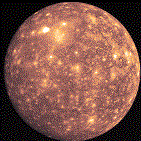  CALLISTO CALLISTO
Callisto is a large, icy, dark-colored, low-density outer moon of Jupiter
that is scarred with impact craters and ejecta. It has a diameter of about 3,000 miles (4800 km), the second-largest moon
of Jupiter; it is roughly the size of Mercury. Callisto has the largest-known impact crater in the Solar System,
Valhalla, which has a bright patch 600 km across and rings that go out to almost 3000 km. Callisto orbits Jupiter at a mean
distance of 1,170,000 miles (1,883,000 km). Its mass is 1.08x1023 kg. It takes Callisto 400.8 hours = 16.7 days
to orbit Jupiter (in a synchronous orbit). Callisto was discovered by Galileo and S. Marius (independently) in 1610. |
JUPITER'S RINGS
Jupiter has faint, dark, narrow rings composed of tiny rock
fragments and dust. They do not contain ice, like Saturn's rings. Jupiter's rings are continuously losing material and being resupplied
with new dust from micrometeors hitting Jupiter's four inner moons (Metis, Adrastea, Amalthea, and Thebe).
Jupiter's rings were
discovered by NASA's Voyager 1 in 1980. The rings were investigated further when Voyager 2 flew by Jupiter.
The rings
have an albedo of 0.05; they do not reflect very much of the sunlight that they receive.
This photo of Jupiter's ring was taken
by NASA's Galileo spacecraft in 1996.
Jupiter's ring is in three sections: the
Main ring, a Halo that orbits closer to Jupiter, and a very wide Gossamer ring that extends far from Jupiter.
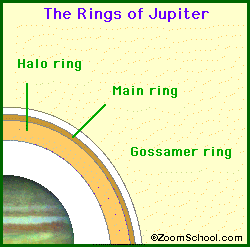 •The Halo ring is a faint, wide ring that has the shape of a doughnut. It is about 22,800 wide and is
about 20,000 km thick. This ring starts at 100,000 km from the center of Jupiter; the outer edge of the Halo merges into the
Main ring. •The Halo ring is a faint, wide ring that has the shape of a doughnut. It is about 22,800 wide and is
about 20,000 km thick. This ring starts at 100,000 km from the center of Jupiter; the outer edge of the Halo merges into the
Main ring.
•The Main ring is 6,400 km wide an less than 30 km thick. This very thin ring has a mass
of about 10 13 kg. The ring is about 7,000 km wide; it starts at 122,800 km from the center of Jupiter and has
an abrupt outer edge 129,130 km from the center of Jupiter. Two small moons, Adrastea and Metis, orbit within the Main ring;
they may be the source of the dust in this ring.
•The Gossamer ring is a very faint and very wide
ring. It consists of two rings, one embedded within the other. It is composed of very tiny particles, the microscopic debris
from the moons, Amalthea and Thebe. The Gossamer ring starts at 129,000 km from the center of Jupiter and extends beyond the
orbit of the moon Amalthea.
TEMPERATURE RANGE
The cloud-tops average 120 K = -153°C = -244°F.
DISCOVERY OF JUPITER
 Jupiter has been well-known since ancient times. It is the third-brightest object in the night sky (after the moon and Venus). Jupiter has been well-known since ancient times. It is the third-brightest object in the night sky (after the moon and Venus).
COMET SL9 HITS JUPITER
Shoemaker-Levy 9 (SL-9) was a short-period comet that was discovered by Eugene and Carolyn Shoemaker and David H. Levy.
As the comet passed close by Jupiter, Jupiter's gravitational forces broke the comet apart . Fragments of the comet collided
with Jupiter for six days during July, 1994, causing huge fireballs in Jupiter's atmosphere that were visible from Earth.
THE GREAT RED SPOT
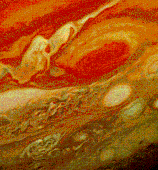 Jupiter's Great Red Spot is a huge, long-lasting storm in the atmosphere of the Southern Hemisphere of Jupiter. It is an anti-cyclonic
(high pressure) storm, much like a gargantuan hurricane. Its color is actually pink to orange. Jupiter's Great Red Spot is a huge, long-lasting storm in the atmosphere of the Southern Hemisphere of Jupiter. It is an anti-cyclonic
(high pressure) storm, much like a gargantuan hurricane. Its color is actually pink to orange.
This whirlwind varies
in size and color from year to year. It is about 17,000 miles (28,000 km) long and 9,000 miles (14,000 km) wide; it is the
biggest storm in this solar system. It is so big that the three Earths would fit in it with room to spare.
Jupiter's Great Red Spot was discovered in 1664 by Robert Hooke. Part of the reason it lasts so long in comparison
with Earth storms (other than the huge difference in scale and the existence of an internal heat source on Jupiter) is that
this storm never goes over land; on Earth, hurricanes loses most of their energy and die when they stray over land.
The
smaller white spots are also giant storms. The colors we see are the result of chemical reactions occurring in the atmosphere.
BELTS AND ZONES
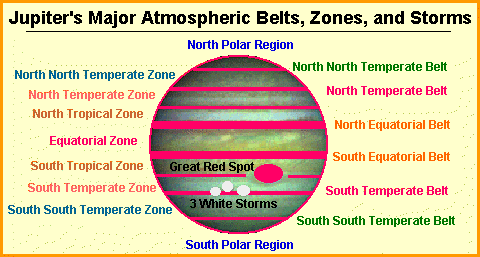
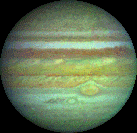 Jupiter's gaseous surface is very windy, with wind speeds exceeding 400 mph (620 kph) in wide bands of latitude. Winds in
adjacent bands blow in opposite directions. The light colored bands we see are called zones; the dark ones are called belts. Jupiter's gaseous surface is very windy, with wind speeds exceeding 400 mph (620 kph) in wide bands of latitude. Winds in
adjacent bands blow in opposite directions. The light colored bands we see are called zones; the dark ones are called belts.
The differences in colors are caused by slight differences in chemical composition and temperature, but the reasons
are mostly unknown. The color of a region depends on its altitude (height).
Measurements performed by NASA's Pioneer
spacecraft in 1973 determined that the dark belts are warmer than the light zones. This probably means that the dark (warmer)
belts are at lower altitudes than the light (colder) zones.
FILL IN THE BLANKS:
Jupiter is the ________________________ planet from the Sun and the
________________________ planet in our Solar System. It is a gas giant planet that has a thick atmosphere, dozens of moons,
and a dark, barely-visible ring. Jupiter's most prominent features are bands across its latitudes and a great ________________________
spot (which is a huge storm). Jupiter was named after the Roman primary god, Jupiter.
Jupiter is composed mostly of ________________________. This enormous planet radiates twice as much heat as it absorbs
from the ________________________. It also has an extremely strong magnetic ________________________. The planet is slightly
flattened at its ________________________ and it bulges out a bit at the equator.
It takes Jupiter 9.8 Earth hours to revolve around its ________________________ (this is a Jovian day). It takes 11.86
Earth years for Jupiter to orbit the Sun once (this is a ________________________ year).
Jupiter's diameter is 88,700 miles (142,800 km). This is a little more than 11 times the diameter of the Earth. Jupiter
is so big that all the other planets in our Solar ________________________ could fit inside Jupiter (if it were hollow).
Jupiter's mass is about 318 times the mass of the Earth, but the ________________________ on Jupiter is only about 2.54
times of the gravity on Earth. This is because Jupiter is such a large planet (and the gravitational force a planet exerts
upon an object at the planet's surface is proportional to its mass and to the inverse of its radius squared). A 100-pound
person would weigh ________________________ pounds on Jupiter.
In ________________________, Galileo first discovered the four largest moons of Jupiter, Io (which is volcanically active),
Europa, Ganymede (the largest of Jupiter's moons), and Callisto; these moons are known as the ________________________ moons.
Ganymede is the largest ________________________ in the Solar System.
ANSWERS:
Jupiter is the fifth planet from the Sun and the largest planet in our Solar System. It is a gas giant planet
that has a thick atmosphere, dozens of moons, and a dark, barely-visible ring. Jupiter's most prominent features are bands
across its latitudes and a great red spot (which is a huge storm). Jupiter was named after the Roman primary god, Jupiter.
Jupiter is composed mostly of gas. This enormous planet radiates twice as much heat as it absorbs from the Sun.
It also has an extremely strong magnetic field. The planet is slightly flattened at its poles and it bulges
out a bit at the equator.
It takes Jupiter 9.8 Earth hours to revolve around its axis (this is a Jovian day). It takes 11.86 Earth years for
Jupiter to orbit the Sun once (this is a Jovian year).
Jupiter's diameter is 88,700 miles (142,800 km). This is a little more than 11 times the diameter of the Earth. Jupiter
is so big that all the other planets in our Solar System could fit inside Jupiter (if it were hollow).
Jupiter's mass is about 318 times the mass of the Earth, but the gravity on Jupiter is only about 2.54 times of
the gravity on Earth. This is because Jupiter is such a large planet (and the gravitational force a planet exerts upon an
object at the planet's surface is proportional to its mass and to the inverse of its radius squared). A 100-pound person would
weigh 254 pounds on Jupiter.
In 1610, Galileo first discovered the four largest moons of Jupiter, Io (which is volcanically active), Europa,
Ganymede (the largest of Jupiter's moons), and Callisto; these moons are known as the Galilean moons. Ganymede is the
largest moon in the Solar System.
|

